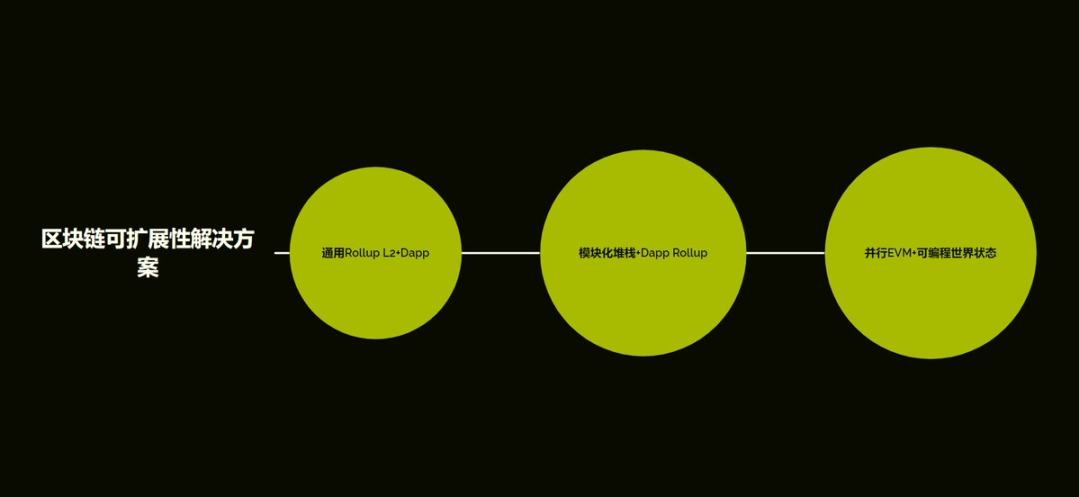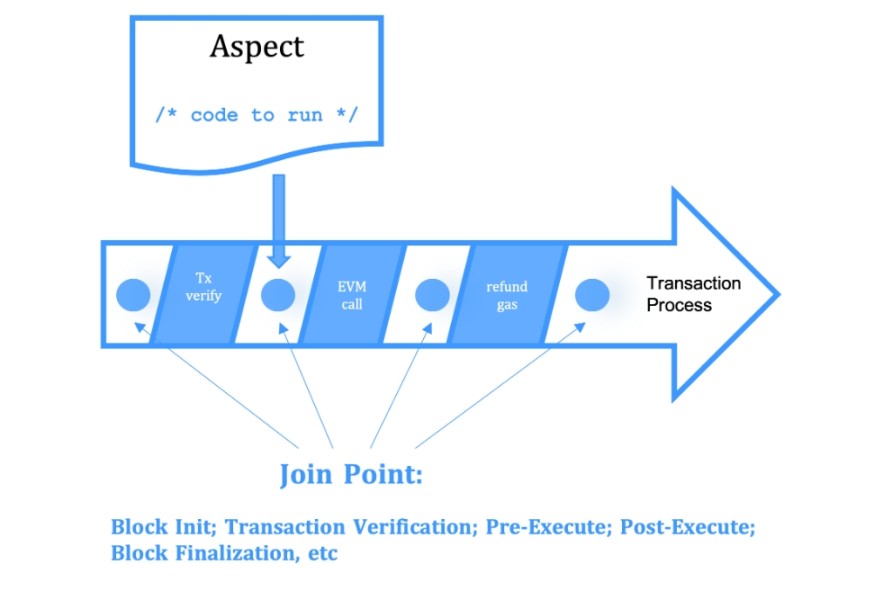 web3.0
web3.0
 A third solution to scalability? Interpretation of parallel EVM + programmable world state solution
A third solution to scalability? Interpretation of parallel EVM + programmable world state solution
A third solution to scalability? Interpretation of parallel EVM + programmable world state solution
In order to solve the problem of blockchain scalability, the encryption industry currently provides three solutions: universal Rollup L2 Dapp, modular stack Dapp Rollup (RollAPP), and parallel EVM programmable world state.

There is a certain inheritance-development relationship between these three solutions.
General Rollup L2 Dapp, the design idea is to spread the pie-style parallel expansion. Except for Starknet and Metis, all other general-purpose Rollup L2s are fully equivalent to Ethereum, just like the "extended version of Ethereum" as the Optimism Slogan puts it.
General Rollup L2’s original intention to pursue Ethereum equivalence is to become one of the most competitive Ethereum execution layers and maximize the siphoning of users, assets and developers from Ethereum.
But in the actual production environment, one after another similar general Rollup L2 launches highly similar developer Grant programs and Odyssey tasks. Developers have to repeatedly deploy the same Dapp application in different general Rollup L2s, and users have to experience the same Dapp application in different general Rollup L2s.
Although this architecture effectively improves the scalability of L1 through the innovation of the resale block space model, it is completely "infrastructure-based" and the sovereignty and user experience of Dapp developers are almost completely ignored. .
This is an important reason for the collective adjustment of the price of the native token of the general Rollup L2 protocol after the Cancun upgrade is expected to be realized.
In response to the bottleneck of the Rollup L2 Dapp scalability solution, projects such as Celestia, Dymension, Avail, and Near have proposed new solutions: modular stack Dapp Rollup.
The modular stack engineers the design concept of "centralized block production, decentralized block verification" by introducing data availability adoption (DAS) technology into the block verification process, ensuring block space. Without reducing the trustless features, block production costs have been significantly reduced, thus reducing the development and deployment costs of Rollup. On the Raas service provider platform, you can deploy a Rollup for as little as $5,000.
In this new situation, developing and deploying a Dapp-specific Rollup has become a popular new trend. Many projects such as PerpDEX, Web3 games, NFT markets, AI Agents, Chain Abstraction, Depin, etc. began to use the modular stack Dapp Rollup to build the underlying infrastructure of their stacks.
However, although this solution returns sovereignty to developers, it results in further fragmentation of user experience and further isolation of funds. Faced with this situation, chain abstraction has become a new popular design space. However, this complex structure nested in layers has also attracted some skepticism in the market. Ethereum is somewhat addicted to layers, as Solana’s short video lampooning Ethereum maxi demonstrates.
Therefore, the solution for the parallel EVM programmable world state intends to "learn from the foreigners and use their skills to defeat the foreigners", abstracting the parallel VM and programmable world state, the core features of Solana's high-performance public chain, into functional modules. To solve the scalability issues of other blockchains (mainly Bitcoin and Ethereum).
Parallel EVM is easy to understand, that is, redesigning the Tx life cycle of EVM and adding parallel processing processes. The core issues that need to be solved by parallel EVM are: state conflict handling strategy, computing performance optimization, disk IO bottleneck breakthrough and performance predictability.
The concept of programmable world state is relatively new and relatively abstract. In the field of blockchain design, the world state refers to the collection of status information of all accounts on the blockchain at a specific moment. The world state includes the balance of each account, the status of smart contracts, and other related information. In the design of EVM, the state is bound to each account (including EOA address and smart contract address). Such a design simplifies state management, is easy to develop, learn and understand, and enhances security, but there are problems with state explosion and parallel processing.
Therefore, among the high-performance public chains, Sui, the parallel EVM public chain @Artela_Network, the modular execution layer public chain Fuel and the full-chain game-specific Rollup Redstone, etc., all choose to design the EVM world state from different architectures. Make magic changes at the level. The programmable world state is a new feature of Artela’s programmable native extension framework Aspect.

As the latest example of a parallel EVM programmable world state scalable solution, Artela is a POS L1 public chain and programmable native extension framework Aspect developed based on Cosmos SDK CometBFT. layer and application layer.
Artela's base layer inherits the characteristics of CometBFT and supports flexible block space. Combined with the programmability of the Aspect layer, Artela allows Dapps to customize exclusive block spaces and achieve the effect of Dapp-specific Rollup on L1. .
The design idea of the Aspect layer is borrowed from the idea of "aspect-oriented" programming. Aspect leverages the complete API set of the base layer to enable programmability of world state by injecting extension logic into specific connection points during the Tx's lifecycle.
The Aspect layer allows Dapp developers to customize the Tx verification process, natively integrate middleware, customize block building rules, access execution context and create trustworthy asynchronous tasks.
For example, Artela cooperates with GO to launch Anti-Rug Aspect, and Artela cooperates with Cellula to launch the full-chain game AI Agent Aspect.
Finally, to summarize, the process of solving the scalability problem of blockchain is a dynamic design space where “pressing the gourd makes the gourd float”. There is no so-called “end game”.
Parallel EVM monad@monad_xyz recently received 225 million in financing, which also hints that top venture capital is betting heavily on a new generation of scalability solutions.
It is time to use the power of technology to solve the problem of blockchain scalability, rather than block space business model innovation like general Rollup L2.
The above is the detailed content of A third solution to scalability? Interpretation of parallel EVM + programmable world state solution. For more information, please follow other related articles on the PHP Chinese website!

Hot AI Tools

Undresser.AI Undress
AI-powered app for creating realistic nude photos

AI Clothes Remover
Online AI tool for removing clothes from photos.

Undress AI Tool
Undress images for free

Clothoff.io
AI clothes remover

Video Face Swap
Swap faces in any video effortlessly with our completely free AI face swap tool!

Hot Article

Hot Tools

Notepad++7.3.1
Easy-to-use and free code editor

SublimeText3 Chinese version
Chinese version, very easy to use

Zend Studio 13.0.1
Powerful PHP integrated development environment

Dreamweaver CS6
Visual web development tools

SublimeText3 Mac version
God-level code editing software (SublimeText3)

Hot Topics
 What currency does Ripple (XRP currency) belong to? Detailed tutorial for beginners
Apr 28, 2025 pm 07:57 PM
What currency does Ripple (XRP currency) belong to? Detailed tutorial for beginners
Apr 28, 2025 pm 07:57 PM
Created by Ripple, Ripple is used for cross-border payments, which are fast and low-cost and suitable for small transaction payments. After registering a wallet and exchange, purchase and storage can be made.
 Which of the top ten currency trading platforms in the world are the latest version of the top ten currency trading platforms
Apr 28, 2025 pm 08:09 PM
Which of the top ten currency trading platforms in the world are the latest version of the top ten currency trading platforms
Apr 28, 2025 pm 08:09 PM
The top ten cryptocurrency trading platforms in the world include Binance, OKX, Gate.io, Coinbase, Kraken, Huobi Global, Bitfinex, Bittrex, KuCoin and Poloniex, all of which provide a variety of trading methods and powerful security measures.
 What are the top ten virtual currency trading apps? The latest digital currency exchange rankings
Apr 28, 2025 pm 08:03 PM
What are the top ten virtual currency trading apps? The latest digital currency exchange rankings
Apr 28, 2025 pm 08:03 PM
The top ten digital currency exchanges such as Binance, OKX, gate.io have improved their systems, efficient diversified transactions and strict security measures.
 Top 10 virtual currency app rankings Recommended by the top ten virtual currency app trading platforms in 2025
Apr 28, 2025 pm 04:12 PM
Top 10 virtual currency app rankings Recommended by the top ten virtual currency app trading platforms in 2025
Apr 28, 2025 pm 04:12 PM
Top 10 virtual currency app rankings: 1. OKX, 2. Binance, 3. gate.io, 4. Coinbase, 5. Kraken, 6. Huobi, 7. Bitfinex, 8. KuCoin, 9. Bitstamp, 10. Gemini, these exchanges are known for their efficient trading systems, rich trading pairs and multiple security measures to meet the needs of different users.
 What are the top currency trading platforms? The top 10 latest virtual currency exchanges
Apr 28, 2025 pm 08:06 PM
What are the top currency trading platforms? The top 10 latest virtual currency exchanges
Apr 28, 2025 pm 08:06 PM
Currently ranked among the top ten virtual currency exchanges: 1. Binance, 2. OKX, 3. Gate.io, 4. Coin library, 5. Siren, 6. Huobi Global Station, 7. Bybit, 8. Kucoin, 9. Bitcoin, 10. bit stamp.
 How much is Bitcoin worth
Apr 28, 2025 pm 07:42 PM
How much is Bitcoin worth
Apr 28, 2025 pm 07:42 PM
Bitcoin’s price ranges from $20,000 to $30,000. 1. Bitcoin’s price has fluctuated dramatically since 2009, reaching nearly $20,000 in 2017 and nearly $60,000 in 2021. 2. Prices are affected by factors such as market demand, supply, and macroeconomic environment. 3. Get real-time prices through exchanges, mobile apps and websites. 4. Bitcoin price is highly volatile, driven by market sentiment and external factors. 5. It has a certain relationship with traditional financial markets and is affected by global stock markets, the strength of the US dollar, etc. 6. The long-term trend is bullish, but risks need to be assessed with caution.
 Bitcoin price today
Apr 28, 2025 pm 07:39 PM
Bitcoin price today
Apr 28, 2025 pm 07:39 PM
Bitcoin’s price fluctuations today are affected by many factors such as macroeconomics, policies, and market sentiment. Investors need to pay attention to technical and fundamental analysis to make informed decisions.
 Binance official website entrance Binance official latest entrance 2025
Apr 28, 2025 pm 07:54 PM
Binance official website entrance Binance official latest entrance 2025
Apr 28, 2025 pm 07:54 PM
Visit Binance official website and check HTTPS and green lock logos to avoid phishing websites, and official applications can also be accessed safely.




